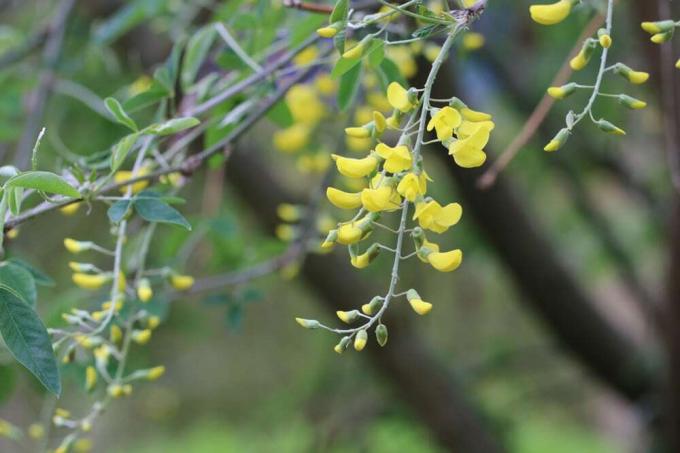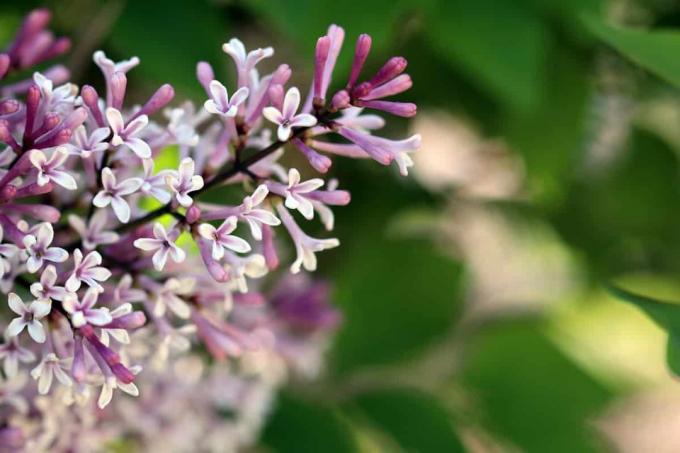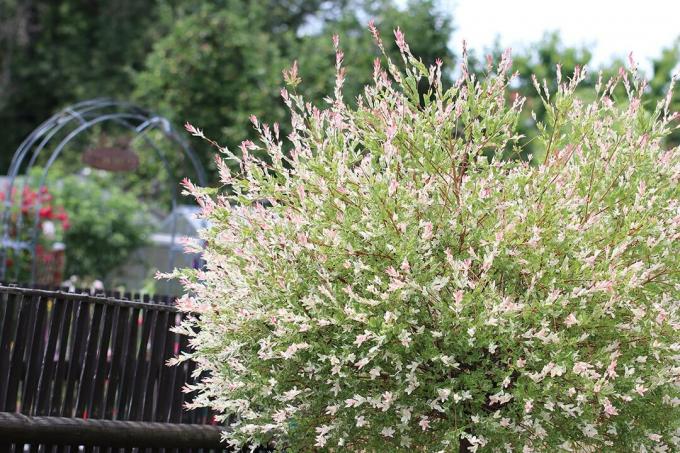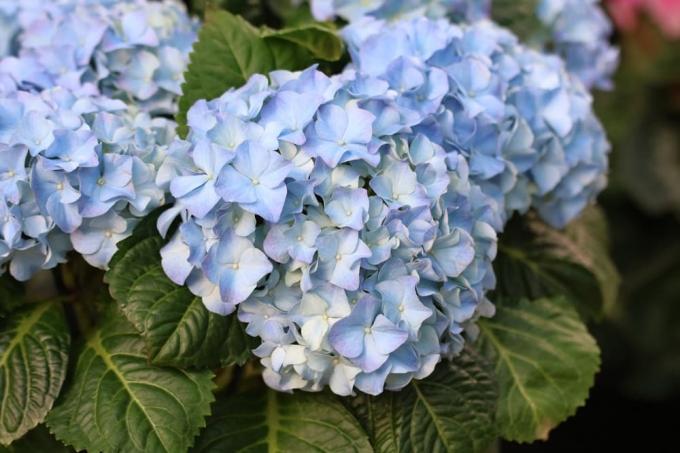

Table of contents
- Flowering time and duration of the different species
- Noble laburnum (Laburnum watereri 'Vossii')
- Alpine Laburnum (Laburnum alpinum)
- Common laburnum (Laburnum anagyroides)
- Laburnum is highly toxic
- Caution, confusion
- Laburnum does not bloom
- age of the plant
- Unfavorable location
- damaged roots
The Laburnum (bot. Laburnum) originally comes from the southern Mediterranean region, where the shrub or Small tree still growing wild today. It owes its popularity in gardens and parks to its magnificent, eponymous flower, because the bright golden yellow flower clusters hang down from the crown like lush curtains. Thanks to the different flowering times of different types of Laburnum, you can enjoy the blooming splendor for a long time.
Flowering time and duration of the different species
When and how long laburnum blooms in the garden depends on the specific species. Basically, two types and a hybrid of these are distinguished from each other. These look very similar on the outside, but do not flower at the same time. Botanists distinguish from each other these species:
- Common laburnum (Laburnum anagyroides)
- Alpine Laburnum (Laburnum alpinum) and
- Noble laburnum (Laburnum watereri 'Vossii')
The species known as noble laburnum is a hybrid of the first two wild species mentioned. Of the three laburnum varieties, it is the most common in parks and gardens, as it flowers particularly magnificently and for a long time in comparison.
Noble laburnum (Laburnum watereri 'Vossii')
- Beginning of flowering: mid to late May
- Flowering period: late May to mid-June
The flower clusters of the noble laburnum, which are up to 50 centimeters long and richly decorated with individual flowers, hang down from the tree like golden-yellow drops. In contrast to the wild species, the flowers of the hybrid form have a very intense, sweet scent. This variety gives the gardener not only the most lush flowering, but also the longest lasting: If the weather is warm and dry, the flower clusters remain in their splendor for up to two weeks consist.
Alpine Laburnum (Laburnum alpinum)
- Beginning of flowering: late May to early June
- Flowering period: mid to late June
The flower clusters of the alpine laburnum, which are also up to 50 centimeters long but light yellow, only appear quite late. Here, too, the duration of flowering depends heavily on the weather: if early summer is warm and dry, you can enjoy the splendor for up to two weeks. In rain and cool temperatures, on the other hand, the flowering period is very short.
Common laburnum (Laburnum anagyroides)
- Beginning of flowering: mid to late May
- Flowering period: late May to mid-June
The common laburnum flowers about one to two weeks before the alpine laburnum, but is in the duration of the Flowering is not as persistent as the hybrid form and is quite short with a few days to a week at most out of. The flower clusters of the common laburnum, which are up to 25 centimeters long, are light to dark yellow in colour.
Laburnum is highly toxic

As beautiful as laburnum flowers and as useful as its pollen-rich blossoms are for insects: all of them Plant parts and in particular the seed-bearing infructescences are highly toxic and potentially dangerous, especially for children deadly. Therefore, only plant Laburnum where children have no access.
Caution, confusion
– The Indian Laburnum –
The Indian laburnum, which is very similar to the species cultivated in this country, bears its name because of it rightly so with its clustered, golden-yellow flowers, but it is not another Laburnum Art. Instead, the tube cassava (bot. Cassia fistula) to the carob family (bot. Caesalpinioideae) and is therefore only distantly related to the laburnums described here. The tree, which is widespread in India and Pakistan, is not hardy as a tropical plant and can therefore only be cultivated in planters. Also in contrast to the Laburnum species, the fruits of the tubular cassia are edible. They are also known by the name "manna".
Laburnum does not bloom
– possible causes and their elimination –
Actually, all laburnum species are just as undemanding as they are willing to flower. Nevertheless, there are some reasons that can result in a lack of flowering.
age of the plant
The most important reason for flowering laziness is probably the age of the laburnum. Specimens grown from seeds in particular need about eight to ten years for their first flowering - so when buying a new one you should look out for older plants grown from cuttings. These usually flower for the first time after about three to five years.
In addition to very young ones, older laburnums are often quite lazy: from an age of approx. After about 15 years, the former abundance of flowers begins to decrease significantly. Now the lifespan of the laburnum is gradually coming to an end, because all species do not usually get very old.
Unfavorable location
Like so many flowering plants, the laburnum develops the most luxuriant flowers in a sunny location. If, on the other hand, he is unwilling, it may be too shady for him. Furthermore, a soil with an acidic pH below 6 or an impermeable substrate that tends to become waterlogged, the flowers will fail. The only thing that helps here is improving the soil and raising the pH value or moving the tree. An alkaline pH between 6.5 and 8 is ideal for laburnum.
damaged roots
When planting the laburnum and later doing soil work, be careful not to damage the sensitive roots. Since these grow flat and close to the surface, you should refrain from rough processing of the root disc. In addition to gardening, voles can also destroy the roots, which is also initially reflected in a failure to flower. If the roots are already so damaged that the tree in question is already shaking, it can no longer be saved. Otherwise, patience and an extra portion of fertilizer (e.g. B. mature compost). Voles should be expelled.
 Home editorial office
Home editorial office
Learn more about ornamental trees

Shell cypress, Chamaecyparis obtusa: 10 care tips
The clam cypress, which originated in Japan, is one of the most popular evergreen garden plants in this country. The 10 most important tips for caring for conifers have been compiled for you here.

Dwarf lilac: 9 tips for care and pruning
The dwarf lilac impresses with its magnificent and fragrant flowers, which at the same time form an ideal retreat for native insects. The nine most important tips for caring for and especially cutting mini lilacs are summarized here for you.

Flamingo Tree: Care and Pruning | flamingo pasture
The flamingo willow (Salix integra 'Hakuro Nishiki'), better known as the harlequin willow, is less noticeable with its inconspicuous flowers than with its colorful leaves. Its crown with the white-pink-green shoots draws everyone's attention, whether as a shrub or as a standard tree.

23 evergreen, hardy & fast growing shrubs
Evergreen and hardy shrubs are ideal for adding color to garden beds, patios and balconies in winter. Fast-growing specimens are particularly in demand. The 23 most popular shrubs can be found in the home garden guide.

The basics of hydrangea care
Hydrangeas provide a real bloom in the garden or on the balcony, as long as they are cared for professionally. Read here how best to do this.

Rhododendron location: 6 important criteria
Rhododendrons are known for their sea of flowers, which, depending on the variety, unfolds its full splendor between March and June. However, the plants only develop the numerous flowers if the location meets their requirements. Rhododendrons are extremely picky when it comes to location.

